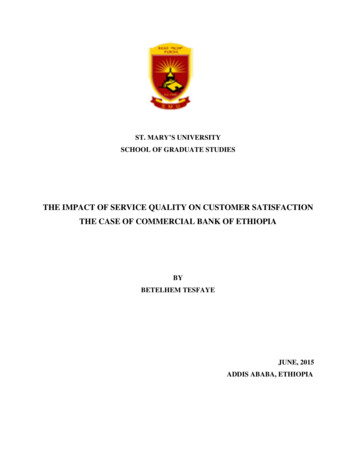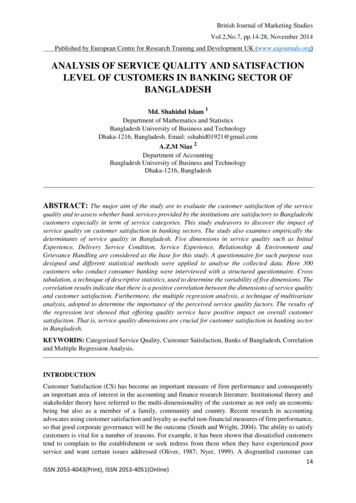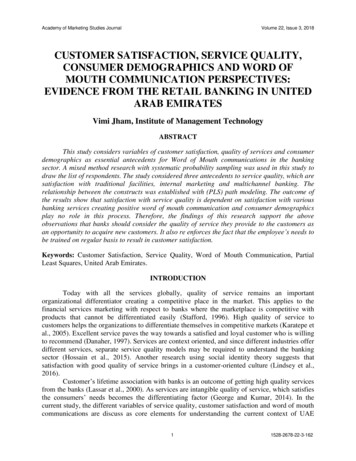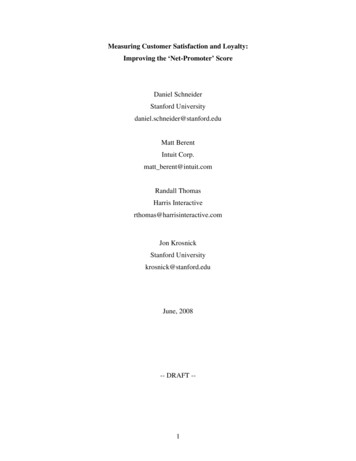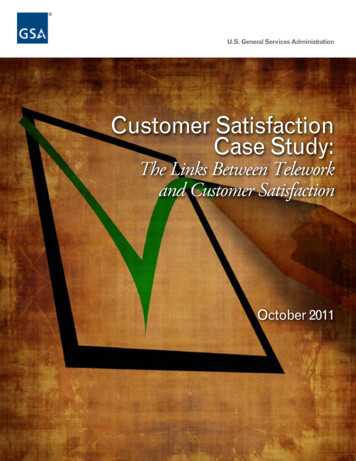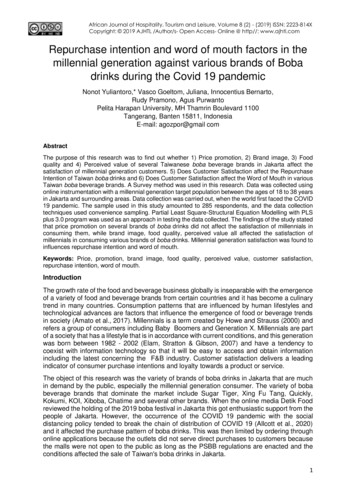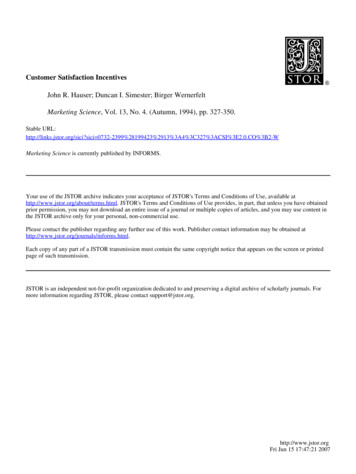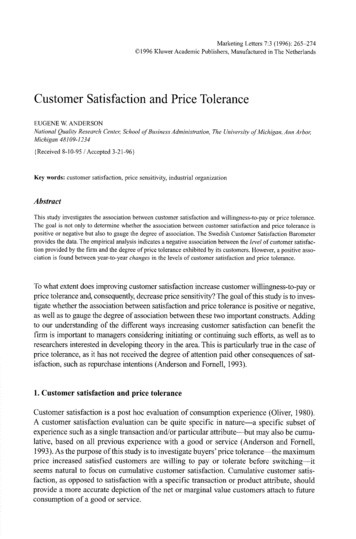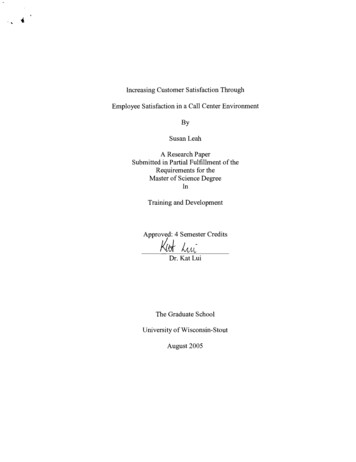
Transcription
Increasing Customer Satisfaction ThroughEmployee Satisfaction in a Call Center EnvironmentSusan LeahA Research PaperSubmitted in Partial Fulfillment of theRequirements for theMaster of Science DegreeInTraining and DevelopmentApproved: 4 Semester CreditsDr. Kat LuiThe Graduate SchoolUniversity of Wisconsin-StoutAugust 2005
The Graduate SchoolUniversity of Wisconsin StoutMenomonie, WI 5475 1ABSTRACTLeahSusan(Writer) (Last Name)(First Name)(Middle Initial)INCREASING CUSTOMER SATISFACTION THROUGH EMPLOYEE SATISFACTIONIN A CALL CENTER ENVIRONMENT(Title)Training and Development(Graduate Program)Dr. Kat LuiAugust 2005(Research Advisor)(MontWYear)63(# of Pages)American Psychological Association, 5thedition(Name of Style Manual Used in this Study)Customer satisfaction is the holy grail of success for businesses in the customerservice industry. A vast array of measurements and tools are implemented to ensure andmeasure customer satisfaction. Many businesses fail to look to one of the key factors inachieving their customer satisfaction goals: the role of the service-providing employee.This study examines the link between employee satisfaction and customersatisfaction, gathers measurements of employee satisfaction in one particular call center thathas struggled with customer satisfaction, and then makes recommendations regarding how toimpact employee satisfaction in this environment.
TABLE OF CONTENTSPage.ABSTRACT.11List of Tables .vChapter I: Introduction.1Statement of the Problem .2Purpose of the Study .2Assumptions of the Study .2Limitations of the Study .3Methodology .3Chapter 11: Literature Review .4Customer Senlice in a Call Center Environment .47Correlation Between Customer and Employee Satisfaction .Employee Satisfaction in a Call Center Environment . 10Summaty . 15Chapter 111: Methodology .16Subject Selection and Description .16Instrumentation .16Data Collection Procedures . 17Data Analysis .17Limitations . 17Chapter IV: Results . 19Trends . 19
Job Satisfaction .21Technology and Tools .24Confidence in Leadership .26Organizational Support and Commitment . 28Role Clarity .31Customer Orientation .32Empathy . 33Additional Comments .34Chapter V: Discussion .37Limitations .37Conclusions .38References .44Appendix: Survey .47
List of Tables21Table 1: Lengths of Employment .Table 2: Item 2. My job provides me with the opportunity to grow and utilize a wide range ofmy skills .22Table 3: Item 3 . My job is viewed as important by employees working in other areas within. .this organization.23Table 4: Item 14. I am satisfied with the way my job performance is measured .24Table 5: Item 10. I am satisfied with the promotional prospects of my job .24Table 6: Item 13. I am satisfied with the influence I have over decisions that affect my job .25Table 7: Item 20 . I receive assignments with adequate resources and materials to execute26them .Table 8: Item 24 . I have all the tools I need to perform my job effectively.26Table 9: Item 19. I see the value in the measurements that are used to access call center27success.21Table 10: Item 37 . My supervisor helps me develop my skills.Table 11: Item 25 . I believe leadership carefully considers the needs of the employees in mydepartment before implementing new policies.29Table 12: Item 32 . I believe leadership supports my efforts to make this a fun and fulfillingplace to work . 29Table 13: Item 42 . I feel changes made in the past year or so are positive for the long-termsuccess of the call center . 3 1
Table 14: Item 70. We will not sacrifice the quality of our products or services in order tomeet goals .33Table 15: Item 77 . Speed is rarely emphasized over satisfying the customers .2 1Table 16: Additional Comments .36
Chapter I: IntroductionIn a medium sized midwestern city, a modest sized company of approximately 150employees has been quietly taking the lead in the veterinary practice management softwareindustry for the past 20 years. As a small division of a large corporation that specializes inthe animal science industry, Company A produces practice management software that isutilized by veterinarians.A significant portion of the services provided by this company come from theirtechnical support call center, which employs approximately 50 customer servicerepresentatives (CSRs) who provide technical software and hardware assistance to theirveterinary clients via telephone. A recent bi-annual survey of veterinarians regardingveterinary practice management software products and companies compiled by an influentialnational veterinary organization, the American Animal Hospital Association (AAHA),reported that customers of Company A are less satisfied with the customer service theyreceive than are customers of their competitors (Berndt, 2004). Similar results were reportedin the same survey conducted two years prior (Berndt, 2002). Despite recent and significantreorganization of the call center that was done in response to this key survey's results twoyears ago, these scores did not rise this year as expected.The results of this survey are very influential in the veterinary industry. Veterinariansand their staff are becoming increasingly oriented toward delivering high quality health careto animals with the assistance of highly technical equipment and software. The vet clinic thatdoes not have a computer system at the core of its operations is a rarity. These clinics arestrongly lead by the guidance of AAHA in making decisions about which practicemanagement software to purchase, which in-clinic lab equipment to install, and whose
laboratory services to use. For this reason, the results of this survey are a strong benchmarkfor success in the veterinary practice management industry.Statement of ProblemIn order to meet the increasingly complex demands of these customers, a customerrelations training program has been implemented in the call center in effort to improve thequality of service being provided, and advanced technical training is provided regularly toincrease technicians' problem solving abilities. This study will demonstrate that there areother significant factors influencing this call center's ability to meet the customer's needs,related to employee satisfaction. What is the status of key employee satisfaction measures inthis call center environment, and how do these key factors affect customer satisfaction?Purpose of the studyThe purpose of this study is to examine the link between customer satisfaction andemployee satisfaction and identify key factors in employee satisfaction. The study willproceed with survey measurement of these key factors in the call center at Company A. In itsconclusion, this study will generate recommendations for future efforts toward employeesatisfaction, aimed at achieving the goal of improved customer satisfaction.Assumptions of the studyThis study assumes that the employee satisfaction survey, which was conducted as apart of this study, reflects an employee's honest opinion about the current work environmentand that issues related to employee satisfaction are similar enough in all customer servicework environments so that the survey instrument used, which drew from other studiespreviously conducted, is relevant.
Limitations of the StudyMany unique environmental and cultural features exist in this call center that may notexist in others. The recent reorganization of the call center dramatically altered the culture,workflow, and reporting structure. Additionally, the services provided by this call center area unique mixture of meeting customers basic service needs (answers to simple softwareusage questions) and resolving customers' technical issues (computer failure, installation ofan entire network, or troubleshooting a network connectivity problem).For these reasons, this study may serve only as a general reference point forapplication in other call center environments. A call center in which the culture had notundergone such extreme changes or one in which the service provided is less complex ormore well defined may not be subject to the same types of employee satisfaction issues asthose that are the focus of this study.MethodologyCase study research methodology was employed utilizing a survey instrument. Thesurvey comprised 93 questions from seven categories (job satisfaction, organizationalsupport and commitment, confidence in leadership, empathy, customer orientation,technology/tools, and role clarity) all measured on a 4-point Likert scale from 1 (stronglydisagree) to 4 (strongly agree). The survey was distributed for voluntary completion to 47customer service representatives within the call center.
Chapter 11: Literature ReviewExperts in the fields of marketing and service management have applied muchscience and measurement to the goal of customer satisfaction. At Company A, workflowreorganization, metrics, salary benchmarking, and surveys and training, in both technicalservices and customer relations, have been implemented toward achieving a goal of increasedcustomer satisfaction without significant success. This literature review will 1) define theaspects of customer service unique to a call center environment, 2) report the correlationbetween customer satisfaction and employee satisfaction, and 3) explore key factors relatedto employee satisfaction in a call center. The goal of the literature review is to identify areasof concern related to employee satisfaction in a call center environment that may have adirect impact on overall customer satisfaction.Customer Service in a Call Center EnvironmentA call center is traditionally defined as a physical location where calls are placed orreceived in high volume for the purpose of sales, marketing, customer service, telemarketing,technical support, or other specialized business activity (Dawson, 1999). It is a complexenvironment that must effectively combine knowledge, technology, and workflow to providequality customer service. A call center is a locus for customer satisfaction. When customerscontact a call center, they expect the phone to be answered promptly and to be treatedcourteously by knowledgeable CSRs who can resolve their issue quickly (Miciak &Desmarais, 2001). Call centers are used in almost every industry imaginable, such as bankingand financial services, technical support, order processing, telemarketing, claims processing,appointment setting and confirmation, membership solicitation or renewal, customeracquisition, customer care, and customer satisfaction surveying. According to D'Ausilio
(2000), more than 90% of customer contact takes place over the phone. In 1993,41% of allcompanies in the U.S. utilized call centers. In 1995, the percentage had effectively doubled at81%. In our culture today, it would be a rare individual who has not had interaction with acompany through a call center.The driving force behind call center management is the hundreds of metrics producedon a regular basis. Call center effectiveness is measured daily by such things as (Carlaw et al,2003):Service level: the percentage of incoming calls answered within a given amount oftime; a goal of usually around 20 seconds or lessAvailable time: time spent by a CSR waiting for calls, e-mails, or chat sessionsAverage speed to answer: the average length of time a customer waits before havingtheir call picked up by a CSRAbandon rate: the percentage of customer who hangs up before a CSR answers theircallAverage talk time: the average length of a telephone contact between the customerand the CSRWrap time: the amount of time an agent spends completing tasks related to one callbefore becoming ready to take anotherThe number of calls received per technician staffedVast arrays of technologies are available to provide this information, allowing micromanagement and adjustment on a minute-by-minute basis. In each call center goals, are setaround these metrics, and the success or failure at meeting those goals is communicated toCSRs with regular frequency by way of computer displays that show information accurate to
the second and reports distributed daily or weekly, among other methods. The success of thecall center is pronounced or denounced on a regular basis depending upon its workers'abilities to meet these goals. However, "if the strategic advantage that call centers aresupposed to afford business revolve around. .customer satisfaction, the most commonmetrics stress many of the things that are counterproductive to these goals" (de Ruyter, p.24). These indicators are effective measures of service speed or efficiency, but may or maynot be true measure of service quality (Miciak and Desmarais, 200 1).Call center metrics are a critical tool used to manage staffing levels and budgets, butthese numbers do not tell the entire story of the call center's ability to meet the customers'needs. Roseanne D' Ausilio, president of Human Technologies Global, Inc., affirms theimportance of measurements in managing a call center and the need to balance that with anunderstanding of the importance of the human element. "If you can't measure it, you can'tmanage it. But, no matter how wonderful the technology, is you should not forget the peoplecomponent. In the case of call centers, the most important resource is the people" (Franklin,2003, p. 11).As call centers increase in importance and prevalence as a means of customer contact,CSRs are becoming an increasingly important link between the company and theircustomers and are critical to the success of the company simply because, in ever increasingnumbers every year, they are the only contact that many customers will have with acompany. "Several survey-based studies of service satisfaction suggest that the humaninteraction component of service delivery is essential to the determination ofsatisfaction/dissatisfaction" (Bitner and Booms, 1990, p. 73). The human element in
customer interactions remains the most important resource in any customer serviceorganization.Correlation Between Customer and Employee SatisfactionFor the purpose of this study, we will define customer satisfaction as the degree towhich a customer reflects a positive impression of services received. There are manydifferent types of service encounters, and different elements create customer satisfaction ineach scenario. Berry, et a1 (1990) identified some principal dimensions customers use tojudge service: tangibles such as the physical appearance of the building, personnel, andmaterials; and intangibles such as reliability, responsiveness, assurance, and empathy. In aface-to-face customer service interaction, such as purchasing a meal at a restaurant, tangibleslike the overall appearance of the service environment and employees and the quality of theproduct purchased, play the most significant a role in the customer's perception of theexperience.In a telephone interaction, all of the tangible aspects of service delivery are removed.The product being purchased is the service interaction. Thus, for call center customers theevaluation of a service depends on the evaluation of a service encounter with a contactemployee (Malhotra & Mukherjee, 2004). Such intangibles as knowledge and accuracy,responsiveness, assurance, and empathy take on greater importance. These dimensions of theservice encounter are directly influenced by the CSR. The quality of the service providercannot be separated from the service offered as it can be during a face-to-face purchase ofgoods for example. For this reason, in a call center services encounter "the competencies ofan agent are likely to have a particularly large influence on the customer's perception ofservice quality" (Pontes & Kelly, 2000, p. 42).
It is the discretionary behavior and actions on the part of the CSR during the callcenter service encounter that determines service quality perceptions and satisfaction(Malhotra & Mukherjee, 2004). Discretionary effort means the maximum effort an employeewill make beyond the basic requirements of their job. These behaviors cannot be controlledby management or trained in a classroom setting. The motivation to "do the right thing"during these discretionary moments must come from an employee's commitment to theorganization, satisfaction with their job, and desire to provide excellent service. It is verydifficult for unhappy and dissatisfied employees to deliver exceptional service (Rogers, et al,1994). The organizational commitment of CSRs plays an important role in customersatisfaction.Researchers in the marketing and human resources fields are paying increasedattention to the outcomes of personal interactions between customers and employees(Malhotra & Mukherjee, 2004, p. 163). "It is generally observed that organizations payinsufficient attention to understanding the nature of the organizational commitment and jobsatisfaction of customer-contact employees who represent the organization to the customerand can directly influence customer satisfaction." The degree of employee satisfactionlargely determines the profits of the company achieved through customer satisfaction andretention. Satisfaction of internal customers is indispensable in achieving satisfaction ofexternal customers (Kondo, 2001).This link between customer satisfaction and employee satisfaction can be effectivelydescribed through the "service-profit chain." The links in the chain are as follows: Businesssuccess (profit) is stimulated by custoiner loyalty, which is a direct result of customersatisfaction. Customer satisfaction is largely influenced by the quality of the service
provided. Employees who are satisfied, loyal, and productive provide high value customerservice (Heskett, et al, 1994). Satisfied employees exist in an environment that providessupport services and policies that assist them in dealing with customers. Value is created bythese satisfied and loyal employees, who in turn create loyal and satisfied customers(Sergeant & Frenkel, 2000).Years of research have firmly grounded the theory that customer satisfaction leads tobusiness success in the form of such factors as positive referrals, loyalty, and repurchaseintentions. One widely quoted statistic in business and marketing journals estimates that a 5%increase in customer loyalty could produce profit increases by as much as 85%. Customerloyalty has been described as customers repeatedly purchasing goods or services over timeand holding a favorable attitude towards those goods, services, or the company providingthem. (Wong & Sohal, 2003). Customer loyalty comes naturally from satisfied customers.Rust, et a1 (1 996) claim employees who recognize and appreciate relationships withcustomers provide better service. Customers who receive better service complain less andcreate fewer problems for employees. Employees react positively to an increase in thesepositive encounters, are more likely to provide better service, and satisfy more customers.Employee satisfaction among service personnel has the potential of increasing customersatisfaction, repeat purchases, and positive references to other potential customers (Rogers, etal, 1994).The remainder of this literature review will examine key employee satisfactionfactors in a call center environment.
Employee Satisfaction in a Call Center EnvironmentEmployee satisfaction has been defined as a pleasurable or positive emotional stateresulting from the appraisal of one's job or job experiences. Certainly many factors have animpact on employee satisfaction. Many studies have been done on the impact of tangiblessuch as physical workspace, pay, and benefits in relation to employee satisfaction. This studychooses to focus on aspects of employee satisfaction such as a supportive work environment,customer orientation, empowerment, role conflict, and empathy; those issues morespecifically related to the intangible aspects of emotion, culture, and morale in a call centerenvironment.The emotional quality of the call center environment plays a significant role inemployee satisfaction. "Agent feelings and desires are perhaps the most forgotten aspect ofcall center management" (Coen, 2001, p.45). The internal quality of the workingenvironment contributes most to employee satisfaction. The feelings that employees havetoward their jobs, colleagues, the company, and the way that people within the organization"serve each other" are factors. (Heskett, et al, 1994). Agents are motivated through therecognition and utilization of their own emotions and the emotional impact made by theirsupervisors. A call center is unique as a work place where the emotions of motivation andexcitement can have a huge impact on productivity and on job satisfaction. Agents report thatthe most satisfying part of the job is when the call ends in the customer's needs having beenmet. If the issue was a particularly challenging one, the emotional satisfaction of a job welldone and a customer satisfied are factors that keep call center employees coming back forinore of what can be a very stresshl role. "Employee satisfaction of intrinsic and spiritualcharacter is the source of excellent quality and customer satisfaction" (Kondo, 2001, p. 871).
Empathy, which can be described as one's ability to match another's emotional stateand provide appropriate sympathy, has been identified as a key component in a satisfactorycall center environment (Rogers, et al, 1994). The level of empathy expressed during aservice encounter will have a strong impact on the quality of the service encounter and theattractiveness of the work climate. CSRs who are very empathetic will produce the highestquality service encounters and will experience the highest level of job satisfaction in acustomer service role. In fact, research has supported the notion that "empathetic concernwill have an inverse impact on job tension" (p. 17).Just as an employee who expresses empathy to a customer reduces tension andincreases service satisfaction, so does empathy expressed by management to employeesdecrease tension and increase job satisfaction. (Rogers, et al, 1994) A work environmentwhere employees feel supported leads to their satisfaction, which leads to customersatisfaction (Sergeant & Frenkel, 2000). Research has shown that CSRs tend to treatcustomers they way they are treated by management. Both immediate supervisor support andteam member support have a direct positive relationship on employee satisfaction. In thissense employees are similar to customers in that their satisfaction and retention are essentialfor business success. A business must be customer oriented with attention paid to bothexternal and internal customers.Customer orientation is defined as the emphasis placed on meeting customer needsand expectations (Dean, 2004). "Previous literature has consistently suggested that if thebusiness wants to satisfy the needs of its customers, it must first satisfy the needs of itsemployees" (Hoffman and Ingram, 1992). Businesses who are customer oriented expendtime and energy to ensure the employees have the tools and support necessary to complete
their jobs. They recognize that CSRs are uniquely aware of the needs of the customer andshould be consulted regularly regarding how to meet those needs. They also seek employeeinput regarding their needs and provide honest and open communication on a regular basis.Employee satisfaction is increased through supportive services and effective policies.Employees who are customer oriented engage in empathetic behaviors that result ingreater customer satisfaction. A customer-oriented employee seeks to assess the customers'needs and help them make good decisions, offers additional services or information, andprovides honest answers and opinions. A study done by Hoffman and Ingram (1 992)determined a significant positive correlation between overall job satisfaction, satisfactionwith work, co-workers and supervisors, and customer orientation. This customer-orientedbehavior is yet another example of the importance of the human element of call centerservice satisfaction.The ability of the CSR to manage the customer relationship and communicateeffectively is a key component of a satisfactory customer service interaction. Customerrelationship management competencies include the ability to personalize the interaction,allow the customer to speak without interruption (occasionally inserting verbal nods such asuh-huh, yes, I see), show appropriate empathy to upset customers, respond in a non-defensivemanner, offer additional services, and thank the customer for calling. Oral communicationcompetencies are the ability to speak at an appropriate volume, use appropriate words, pace,tone and grammar, avoid vocalized pauses (um, ah), and the ability to speak confidently(Pontes & Kelly, 2000). "An agent's customer relationship management and oralcommunication competencies are likely to have a significant influence on a caller'sevaluation of the service"(p.42).
The basis for effective communication is empathy, the ability to understand, andpredict how others might respond in a given circumstance. This empathetic ability is essentialin both internal (management to employee) and external (employee to customer)communications. Without effective communi
veterinary clients via telephone. A recent bi-annual survey of veterinarians regarding veterinary practice management software products and companies compiled by an influential national veterinary organization, the American Animal Hospital Association (AAHA), reported that customers of Company A are less satisfied with the customer service they

